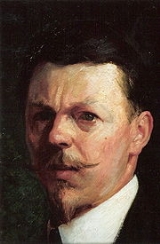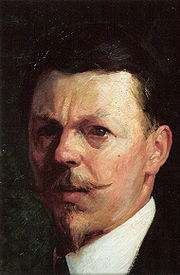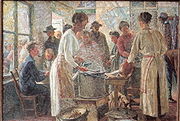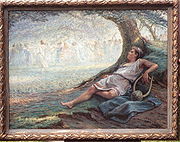
Pieter Franciscus Dierckx
Encyclopedia

He was a student at the art academy in Antwerp and at the higher institute in Antwerp. His teachers were among others Juliaan De Vriendt, his brother Albert De Vriendt and Karel Verlat.


He became director of the drawing academy of Temse in September 1896 and also taught drawing. He changed the way and content of the teaching and brought the school to a higher level and is regarded as one of the most important directors in the 230 year existence of the drawing academy in Temse.
As an etcher and graphic design
Graphic design
Graphic design is a creative process – most often involving a client and a designer and usually completed in conjunction with producers of form – undertaken in order to convey a specific message to a targeted audience...
er he provided his services to clubs and societies.
In 1899 he illustrated “Studentenliederboek” (student song book) of Karel Heyndrickx and in 1910 a few children's stories
Children's literature
Children's literature is for readers and listeners up to about age twelve; it is often defined in four different ways: books written by children, books written for children, books chosen by children, or books chosen for children. It is often illustrated. The term is used in senses which sometimes...
for the author Lodewijk Scheltjens (1861–1946).
In 1912 he took part in the design of the historic procession in Rupelmonde in honour of the 400 birthday of Mercator.
During the first world war he mainly painted country images like: ”the potato peelers in an old age home“, “a sober meal”, “a thatch making place”, “the lace maker”, “a clog maker”,
“a basket maker”, “the small quay” (1917), “a burned farm”, “a level crossing
Level crossing
A level crossing occurs where a railway line is intersected by a road or path onone level, without recourse to a bridge or tunnel. It is a type of at-grade intersection. The term also applies when a light rail line with separate right-of-way or reserved track crosses a road in the same fashion...
attendant”,
“a weaver family”, “the spinning wheel”, “piety on the heather”, etc.
The main theme in his paintings is landscapes, mainly concentrating on forest views.
He belonged to the neo impressionistic school, therefore light was a very important instrument in his works.
He was also attracted by the historic genre, giving reference to Hendrik Leys.
Franz Courtens, carried a very high esteem of Pieter Dierckx. He recommended Dierckx for the most important order of the town of Lokeren: two paintings for the town hall showing historic events. The first one depicts the emperor Charles V
Charles V, Holy Roman Emperor
Charles V was ruler of the Holy Roman Empire from 1519 and, as Charles I, of the Spanish Empire from 1516 until his voluntary retirement and abdication in favor of his younger brother Ferdinand I and his son Philip II in 1556.As...
handing over the privilege of holding a market every week to the deputies of the city in 1555. The other panel shows the foundation of the Saint Sebastian guild by Albrecht and Isabella in 1613, while issuing the privilege for holding a yearly market. These are big paintings, confirming the greatness of the school of Leys. In addition they show that Pieter Dierckx has the ability to expertly picture an historic event.
In March 1919 he returns to Antwerp and starts a paint studio. In 1939 he confirmed himself as a painter of historic events with the almost 5 m wide painting of “The Saint Willibrordus explaining the bible to the people living on the shores of the river Scheld around 700 AD”. This painting can be admired in the church of the Holy Heart in the Lange Beeldekensstraat 18 in Antwerp.
He painted mythological events with „the dancing sylphides“ and “Orpheus, the soft voiced singer of Tracia”. The latter painting showed the theme of the first one in the background.
He was also a great portraitist.
Since 1952 the “Pieter Dierckx Price for Painting” is issued biannually at the drawing academy in Temse.
In 1986 the town of Temse honoured Pieter Dierckx by naming a street after him.
Exhibitions
- 1896: “XII Exhibition of the Art Society: “Eigen Vorming” in Borgerhout (Antwerp).
- 6 June 1897: “First Exhibition of De Scalden” at the art galleryArt galleryAn art gallery or art museum is a building or space for the exhibition of art, usually visual art.Museums can be public or private, but what distinguishes a museum is the ownership of a collection...
Verlat, Antwerp. - 25 March 1900: “Third Exhibition of Monumentals, Ornamentals and Applied ArtsApplied artApplied art is the application of design and aesthetics to objects of function and everyday use. Whereas fine arts serve as intellectual stimulation to the viewer or academic sensibilities, the applied arts incorporate design and creative ideals to objects of utility, such as a cup, magazine or...
of De Scalden” at the Old - Museum in Antwerp. - 1924: at the art gallery “Loquet” in Antwerp.
- 30 November 1925: at the art gallery “Jordaens” Korte Klarenstraat in Antwerp.
- February 1977: at the town hall of Temse on occasion of the 200th anniversary of the Academy.
- From 24 June to 13 August 2006: retrospective at the museum of Temse.
Salons
- Antwerp: 1901, 1904, 1908, 1911.
- Brussels: 1903.
- Liège: 1909.
- Ghent: 1913.
- Budapest, Munich, Florence (1907–1908), Paris.
- “Third Exhibition of 1911” at the Exhibition HallConvention centerA convention center is a large building that is designed to hold a convention, where individuals and groups gather to promote and share common interests. Convention centers typically offer sufficient floor area to accommodate several thousand attendees...
, Meir in Antwerp. - “Second Exhibition - December” organized by “The National Association of Painters and Sculptors of Belgium”.
Publications
- “Ons Volk ontwaakt” (23 August 1913).
- “Le Carnet Mondain” (7 December 1913).
- “Anvers Artistique” (15 April 1924).
- “La Revue Moderne illustrée et de la Vie” (15 May 1939), Paris.
- “Künstlerlexikon des XIX Jahrhunderts”. Allgemeines Lexikon der bildeten Künstler des XX Jahrhunderts” published by Hans Vollmer (1953) - VEB Seeman Verlag Lepzig.
- “De Autotoerist” (4 February 1971), biweekly bulletin of the Flemisch Motorist Association.
- The art book: “Parels langs de Scheldekant, deel II (1980), composed by Leo Busschaert, Waasmunster, Belgium.
- “Lexikon of the Belgian Romantic Painters” by W. Flippo (International Art Book Publishers, Antwerp 1981).
- “The Artist Dictionary Arto” (1999), composed by Wim Pas, published by De Gulden Roos.
- “Dictionnaire des peintres belges nés entre 1750 et 1875” (Editions Laconti Brussels, P&V Berko, Knokke).
- “Openbaar Kunstbezit” of the town Lokeren (Belgium), 31 May 2000.
- The newspapers: “Het Nieuwsblad“, “De Standaard“, “De Gentenaar“, “Het Volk” on the occasion of the retrospective at the museum of Temse (24 June-13 August 2006).
- “The Belgian Visual Artists of the 19nd and the 20th Century” by Paul Piron, published by Art Belgium.
- “Belgian Artists Signatures: Signatures of Belgian Artists of the XIX and XX Century” by Paul Piron, published by Arts, Antiques, Auctions.

